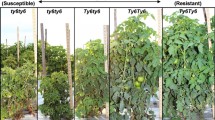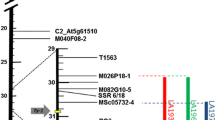Abstract
Resistance to begomoviruses including bipartite Tomato mottle virus (ToMoV) and monopartite Tomato yellow leaf curl virus (TYLCV) has been introgressed to cultivated tomato (Solanum lycopersicum) from S. chilense accessions LA1932, LA2779, and LA1938. Previous research demonstrated that three regions on chromosome 6 were associated with the resistance, two of which were required for a line to provide a high level of resistance. In the present study, we identified a large S. chilense introgression spanning markers from C2_At2g39690 to T0834 in LA2779-derived advanced breeding lines resistant to both TYLCV and ToMoV. A begomovirus resistance locus, Ty-3, was mapped to the marker interval between cLEG-31-P16 and T1079 on the long arm of chromosome 6. In addition to the Ty-3 locus, the large introgression also spans the Ty-1 region near the Mi gene, suggesting the possible coexistence and linkage of resistance alleles at both Ty-1 and Ty-3 loci in these lines. In contrast, LA1932-derived advanced breeding lines possess a much shorter introgression from cLEG-31-P16 to C2_At5g41480, which also carries a begomovirus resistance locus that is probably allelic at the Ty-3 locus. The PCR-based markers tightly linked to the Ty-3 locus as well as the markers near the Ty-1 region have been used in our breeding program for efficient selection of begomovirus resistance in the past three growing seasons and will be useful resources for tomato breeders around the world.

Similar content being viewed by others
Notes
Recently proposed nomenclature for wild and cultivated tomatoes (Peralta et al. 2006).
References
Agrama HA, Scott JW (2006) Quantitative trait loci for tomato yellow leaf curl virus and tomato mottle virus resistance in tomato. J Am Soc Hortic Sci 131:267–272
Alpert KB, Tanksley SD (1996) High-resolution mapping and isolation of a yeast artificial chromosome contig containing fw2.2: a major fruit weight quantitative trait locus in tomato. Proc Natl Acad Sci USA 93:15503–15507
Bai Y, Huang CC, van der Hulst R, Meijer-Dekens F, Bonnema G, Lindhout P (2003) QTLs for tomato powdery mildew resistance (Oidium lycopersici) in Lycopersicon parviflorum G1.1601 co-localize with two qualitative powdery mildew resistance genes. Mol Plant Microbe Interact 16:169–176
Bai Y, van der Hulst R, Bonnema G, Marcel BC, Meijer-Dekens F, Niks RE, Lindhout P (2005) Tomato defense to Oidium neolycopersici: Dominant Ol genes confer isolate-dependent resistance via a different mechanism than recessive ol-2. Mol Plant Microbe Interact 18:354–362
Canady MA, Ji Y, Chetelat RT (2006) Homeologous recombination in Solanum lycopersicoides introgression lines of cultivated tomato. Genetics 174:1775–1788
Chagué V, Mercier JC, Guénard M, de Courcel A, Vedel F (1997) Identification of RAPD markers linked to a locus involved in quantitative resistance to TYLCV in tomato by bulked segregant analysis. Theor Appl Genet 95:671–677
Friedmann M, Lapidot M, Cohen S, Pilowsky M (1998) A novel source of resistance to tomato yellow leaf curl virus exhibiting a symptomless reaction to viral infection. J Am Soc Hortic Sci 123:1004–1007
Fulton TM, Chunwongse J, Tanksley SD (1995) Microprep protocol for extraction of DNA from tomato and other herbaceous plants. Plant Mol Biol Rep 13:207–209
Fulton TM, Van der Hoeven R, Eannetta NT, Tanksley SD (2002) Identification, analysis, and utilization of conserved ortholog set markers for comparative genomics in higher plants. Plant Cell 14:1457–1467
Griffiths PD (1998) Inheritance and linkage of geminivirus resistance genes derived from Lycopersicon chilense (Dunal) in tomato (Lycopersicon esculentum Mill). PhD dissertation, University of Florida, Gainesville
Griffiths PD, Scott JW (2001) Inheritance and linkage of tomato mottle virus resistance genes derived from Lycopersicon chilense accession LA 1932. J Am Soc Hortic Sci 126:462–467
Guyot R, Cheng X, Su Y, Cheng Z, Schlagenhauf E, Keller B, Ling H-Q (2005) Complex organization and evolution of the tomato pericentromeric region at the fer gene locus. Plant Physiol 138:1205–1215
Hanson P, Green SK, Kuo G (2006) Ty-2, a gene on chromosome 11 conditioning geminivirus resistance in tomato. Tomato Genet Coop Rep 56:17–18
Hanson PM, Bernacchi D, Green S, Tanksley SD, Muniyappa V, Padmaja AS, Chen H, Kuo G, Fang D, Chen J (2000) Mapping a wild tomato introgression associated with tomato yellow leaf curl virus resistance in a cultivated tomato line. J Am Soc Hortic Sci 15:15–20
Hassan AA, Wafi MS, Quronfilah NE, Obaji UA, Al-Rayis MA, Al-Izabi F (1991) Screening for tomato yellow leaf curl virus resistance in wild and domestic Lycopersicon accessions. Tomato Genet Coop Rep 41:19–21
Ji Y, Chetelat RT (2003) Homoeologous pairing and recombination in Solanum lycopersicoides monosomic addition and substitution lines of tomato. Theor Appl Genet 106:979–989
Ji Y, Scott JW (2005) Identification of RAPD markers linked to Lycopersicon chilense derived geminivirus resistance genes on chromosome 6 of tomato. Acta Hortic 695:407–416
Ji Y, Scott JW, Hanson P, Graham E, Maxwell DP (2007) Sources of resistance, inheritance, and location of genetic loci conferring resistance to members of the tomato-infecting begomoviruses. In: Czosnek H (ed) Tomato yellow leaf curl virus disease: Management, molecular biology, Breeding for resistance. Kluwer, Dordrecht (in press)
Kalloo G, Banerjee MK (1990) Transfer of tomato leaf curl virus resistance from Lycopersicon hirsutum f. glabratum to L. esculentum. Plant Breed 105:156–159
Kaloshian I, Yaghoobi J, Liharska T, Hontelez J, Hanson D, Hogan P, Jesse T, Wijbrandi J, Simons G, Vos P, Zabel P, Williamson VM (1998) Genetic and physical localization of the root-knot nematode resistance locus Mi in tomato. Mol Gen Genet 257:376–385
Lander ES, Green P, Abrahamson J, Barlow A, Daly J, Lincoln SE, Newburg L (1987) MAPMAKER: an interactive computer package for constructing primary genetic linkage maps of experimental and natural populations. Genomics 1:174–181
Lapidot M, Friedmann M, Lachman O, Yehezkel A, Nahon S, Cohen S, Pilowsky M (1997) Comparison of resistance level to tomato yellow leaf curl virus among commercial cultivars and breeding lines. Plant Dis 81:1425–1428
Laterrot H (1993) Present state of the genetic control of tomato yellow leaf curl virus and of the ECC-supported breeding programme. In: Stamova L (ed) Proc 12th Eucarpia Meet Tomato Genet Breed. Maritsa Vegetable Crops Research Institute, Plovdiv, Bulgaria, pp 19–24
Lincoln S, Daly M, Lander ES (1993) Mapping genes controlling quantitative traits with MAPMAKER/QTL 1.1: a tutorial and reference manual. Whitehead Institute Technical Report, 2nd edn. Whitehead Institute, Cambridge, Mass.
Ling HQ, Pich A, Scholz G, Ganal MW (1996) Genetic analysis of two tomato mutants affected in the regulation of iron metabolism. Mol Gen Genet 252:87–92
Maxwell DP, Martin C, Salus MS, Montes L, Mejía L (2006) Breeding tomatoes for resistance to tomato-infecting begomoviruses. International Plant Virology Laboratory, University of Wisconsin-Madison. http://www.plantpath.wisc.edu/GeminivirusResistantTomatoes/index.htm. Cited: 23 October 2006
Mejía L, Teni RE, Vidavski F, Czosnek H, Lapidot M, Nakhla MK, Maxwell DP (2005) Evaluation of tomato germplasm and selection of breeding lines for resistance to begomoviruses in Guatemala. Acta Hortic 695:251–256
Milo J (2001) The PCR-based marker REX-1, linked to the gene Mi, can be used as a marker to TYLCV tolerance. In: Proc Tomato Breed Roundtable. http://www.oardc.ohio-state.edu/tomato/TBRT%202001%20Abstracts.pdf
Monforte AJ, Tanksley SD (2000) Fine mapping of a quantitative trait locus (QTL) from Lycopersicon hirsutum chromosome 1 affecting fruit characteristics and agronomic traits: breaking linkage among QTLs affecting different traits and dissection of heterosis for yield. Theor Appl Genet 100:471–479
Peralta IE, Knapp S, Spooner DM (2006) Nomenclature for wild and cultivated tomatoes. Tomato Genet Coop Rep 56:6–12
Pico B, Diez MJ, Nuez F (1996) Viral diseases causing the greatest economic losses to the tomato crop .2. The tomato yellow leaf curl virus – a review. Sci Hortic 67:151–196
Pico B, Diez M, Nuez F (1998) Evaluation of whitefly-mediated inoculation techniques to screen Lycopersicon esculentum and wild relatives for resistance to tomato yellow leaf curl virus. Euphytica 101:259–271
Pico B, Ferriol M, Diez M, Nuez F (1999) Developing tomato breeding lines resistant to tomato yellow leaf curl virus. Plant Breed 118:537–542
Pilowsky M, Cohen S (1990) Tolerance to tomato yellow leaf curl virus derived from Lycopersicon peruvianum. Plant Dis 74:248–250
Polston JE, Anderson PK (1997) The emergence of whitefly-transmitted geminiviruses in tomato in the western hemisphere. Plant Dis 81:1358–1369
Scott JW (2001) Geminivirus resistance derived from Lycopersicon chilense accessions LA1932, LA1938, and LA2779, In: Proc Tomato Breed Roundtable, Antigua. http://www.oardc.ohio-state.edu/tomato/TBRT%202001%20Abstracts.pdf
Scott JW (2006) Breeding for resistance to viral pathogens. In: Razdan MK, Mattoo AK (eds) Genetic improvement of solanaceous crops, vol. 2: tomato. Science Publ, Enfield, pp 447–474
Scott JW, Schuster DJ. (1991) Screening of accessions for resistance to the Florida tomato geminivirus. Tomato Genet Coop Rep 41:48–50
Scott JW, Stevens MR, Barten JHM, Thome CR, Polston JE, Schuster DJ, Serra CA (1995) Introgression of resistance to whitefly-transmitted geminiviruses from Lycopersicon chilense to tomato. In: Gerling D, Mayer RT (eds) Bemisia: Taxonomy, biology, damage control, and management. Intercept, Andover, UK, pp 357–367
van der Vossen EAG, Gros J, Sikkema A, Muskens M, Wouters D, Wolters P, Pereira A, Allefs S (2005) The Rpi-blb2 gene from Solanum bulbocastanum is an Mi-1 gene homolog conferring broad-spectrum late blight resistance in potato. Plant J 44:208–222
Vidavsky F, Lapidot M, Czosnek H (2006) Pile up of resistance genes to TYLVC found in wild species to produce resistant cultivars. In: Tomato Breeders Roundtable. Tampa, Florida
Vidavsky F, Czosnek H (1998) Tomato breeding lines resistant and tolerant to tomato yellow leaf curl virus issued from Lycopersicon hirsutum. Phytopathology 88:910–914
Vidavsky F, Leviatov S, Milo J, Rabinowitch HD, Kedar N, Czosnek H (1998) Response of tolerant breeding lines of tomato, Lycopersicon esculentum, originating from three different sources (L. peruvianum, L. pimpinellifolium and L. chilense) to early controlled inoculation by tomato yellow leaf curl virus (TYLCV). Plant Breed 117:165–169
Williamson VM, Ho JY, Wu FF, Miller N, Kaloshian I (1994) A PCR-based marker tightly linked to the nematode resistance gene, Mi, in Tomato. Theor Appl Genet 87:757–763
Zamir D, Eksteinmichelson I, Zakay Y, Navot N, Zeidan M, Sarfatti M, Eshed Y, Harel E, Pleban T, Vanoss H, Kedar N, Rabinowitch HD, Czosnek H (1994) Mapping and introgression of a tomato yellow leaf curl virus tolerance gene, Ty-1. Theor Appl Genet 88:141–146
Acknowledgements
The authors are grateful to Jose Diaz, Cathy Provenzano, and Rosa Ayala for technical assistance and maintaining plants; to Christopher T. Martin and Douglas P. Maxwell for sharing their sequence data and creative insights relevant to the current research; and to crew members in David J. Schuster’s lab for assistance in virus inoculation. Craig K. Chandler and Zhanao Deng provided constructive comments on the manuscript. This research was supported in part by grants from Unilever Bestfoods Ltd. and the Florida Tomato Committee.
Author information
Authors and Affiliations
Corresponding author
Additional information
An erratum to this article can be found at http://dx.doi.org/10.1007/s11032-007-9102-1
Rights and permissions
About this article
Cite this article
Ji, Y., Schuster, D.J. & Scott, J.W. Ty-3, a begomovirus resistance locus near the Tomato yellow leaf curl virus resistance locus Ty-1 on chromosome 6 of tomato. Mol Breeding 20, 271–284 (2007). https://doi.org/10.1007/s11032-007-9089-7
Received:
Accepted:
Published:
Issue Date:
DOI: https://doi.org/10.1007/s11032-007-9089-7




